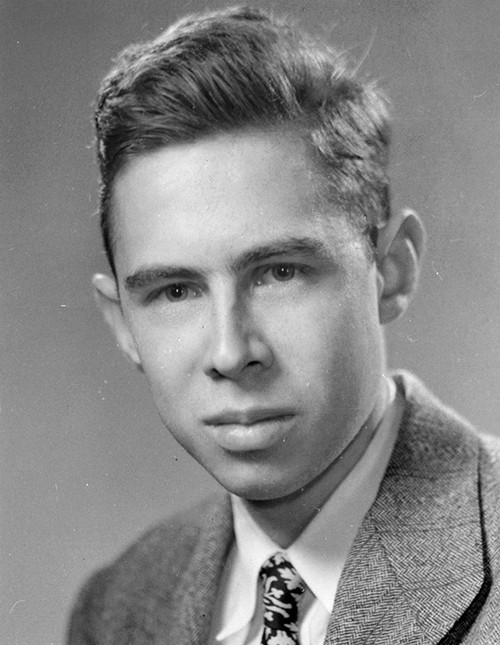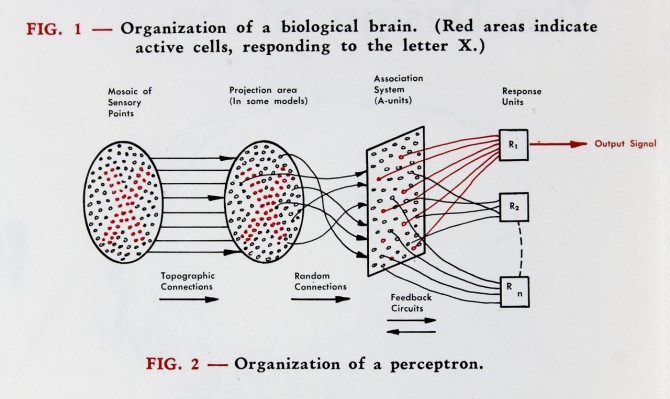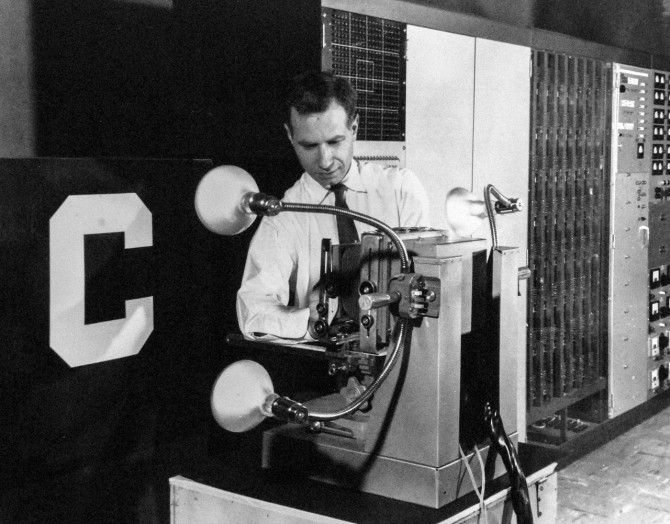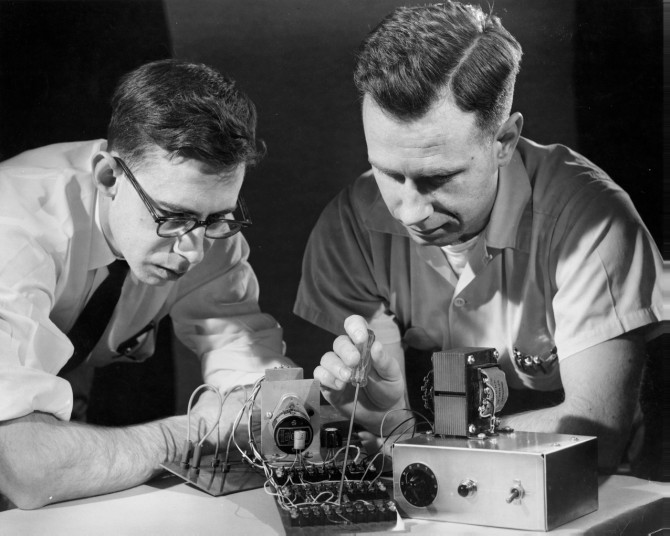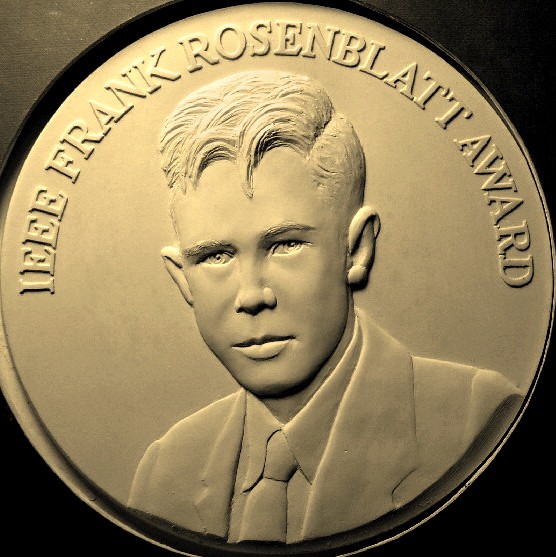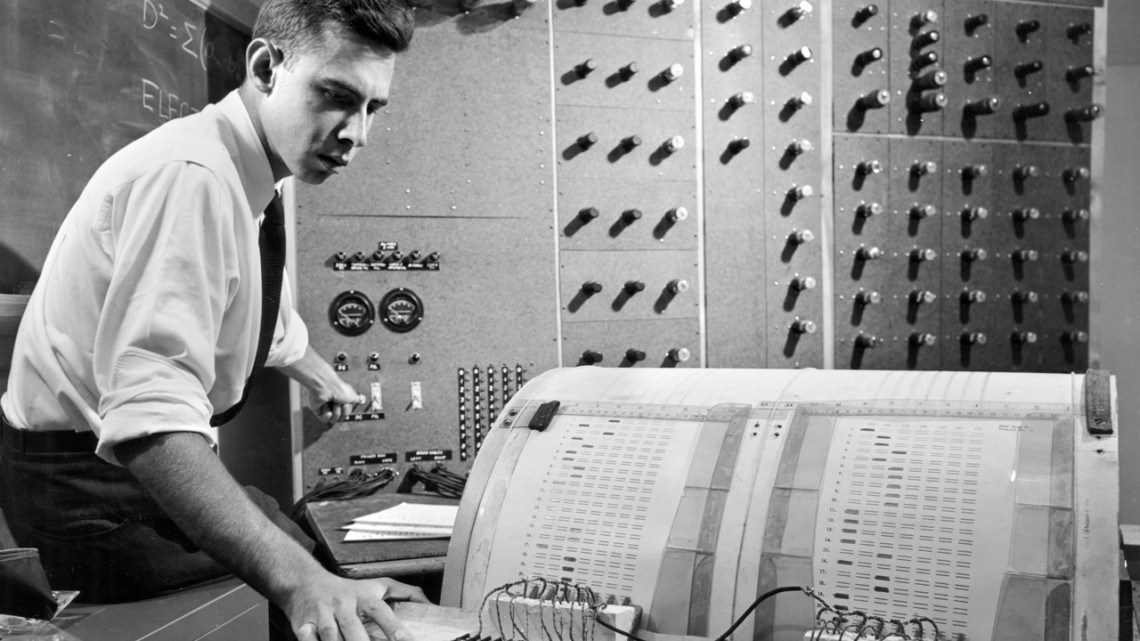
Frank Rosenblatt ’50, Ph.D. ’56, works on the “electronic profile analyzing computer” – a precursor to the perceptron.
Professor’s perceptron paved the way for AI – 60 years too soon
By Melanie Lefkowitz
In July 1958, the U.S. Office of Naval Research unveiled a remarkable invention.
An IBM 704 – a 5-ton computer the size of a room – was fed a series of punch cards. After 50 trials, the computer taught itself to distinguish cards marked on the left from cards marked on the right.
It was a demonstration of the “perceptron” – “the first machine which is capable of having an original idea,” according to its creator, Frank Rosenblatt ’50, Ph.D. ’56.
At the time, Rosenblatt – who later became an associate professor of neurobiology and behavior in Cornell’s Division of Biological Sciences – was a research psychologist and project engineer at the Cornell Aeronautical Laboratory in Buffalo, New York.
“Stories about the creation of machines having human qualities have long been a fascinating province in the realm of science fiction,” Rosenblatt wrote in 1958. “Yet we are about to witness the birth of such a machine – a machine capable of perceiving, recognizing and identifying its surroundings without any human training or control.”
He was right – but it took half a century to prove it.
The first serious rival
Rosenblatt’s claims drew keen interest from reporters and the nascent computing community. “NEW NAVY DEVICE LEARNS BY DOING: Psychologist Shows Embryo of Computer Designed to Read and Grow Wiser,” a New York Times headline read. The New Yorker wrote: “Indeed, it strikes us as the first serious rival to the human brain ever devised.”
But skeptics insisted the perceptron was incapable of reshaping the relationship between human and machine. Enthusiasm waned. The perceptron’s rise and fall helped usher in an era known as the “AI winter” – decades in which federal funding for artificial intelligence research dried up. When Rosenblatt died in 1971, his research centered on injecting material from trained rats’ brains into the brains of untrained rats.
Today, many believe Rosenblatt has been vindicated. The principles underlying the perceptron helped spark the modern artificial intelligence revolution. Deep learning and neural networks – which can classify online images, for example, or enable language translation – are transforming society.
As the Faculty of Computing and Information Science (CIS) celebrates its 20th year, Rosenblatt’s prescient research underscores Cornell’s pivotal role in computing history.
“The perceptron was the first neural network,” said Thorsten Joachims, professor in CIS, who teaches about Rosenblatt and the perceptron in his Introduction to Machine Learning course. “The foundations for all of this artificial intelligence were laid at Cornell.”
Techies, nut cases and nerds
Born in 1928, Rosenblatt grew up in New Rochelle, New York, a suburb of New York City, and attended the Bronx High School of Science. At Cornell, he majored in social psychology and earned his Ph.D. in psychology.
This research led him to computing. As a doctoral student, he built an “Electronic Profile Analyzing Computer” to analyze personality data for his dissertation. When he later developed the perceptron, his goal was to solve the mysteries of the brain.
“He wanted to ask himself what are the minimum number of things that a brain has to have physically in order to perform the amazing things it does,” said Richard O’Brien, former director of Cornell’s Division of Biological Sciences, at Rosenblatt’s memorial service.
Inspired by the way neurons work together in the brain, the perceptron is a single-layer neural network – an algorithm that classifies input into two possible categories. The neural network makes a prediction – say, right or left; or dog or cat – and if it’s wrong, tweaks itself to make a more informed prediction next time. It becomes more accurate over thousands or millions of iterations.
In 1959, when Rosenblatt brought the perceptron to the Ithaca campus and became director of Cornell’s Cognitive Systems Research Program and a lecturer in psychology, he was optimistic that breakthroughs lay just ahead.
“We really thought we were on to something,” said Bill Eisner ’62, who worked for Rosenblatt as a programmer. “We had the idea that we were doing some new kind of computing. … It was a kick to be a part of it.”
Eisner was part of a team of mostly graduate students working on a different type of perceptron, the Tobermory. Named after the talking cat in an H.H. Munro story, the Tobermory was designed to recognize speech. It was Rosenblatt’s follow-up to his Mark I perceptron, a visual pattern classifier.
“Frank was the thinker, and we were the worker bees,” said Terrell Koken, recruited by Rosenblatt as a 16-year-old Cornell freshman. Koken, who never graduated, met Rosenblatt over a conversation about Fermat’s Last Theorem in the music lounge – a frequent haunt for “techies, nut cases and nerds,” he said.
Koken was interested in astronomy, and Rosenblatt became interested, too. Rosenblatt bought a $3,000 telescope so large he had no place to put it. So he bought a sprawling house in nearby Brooktondale, New York, and invited several of his graduate students to live there. By day, the team worked on the Tobermory. By night, they built an observatory in Rosenblatt’s yard.
“We were all pretty gung-ho about it,” Koken said. “We went out into the pasture and dug foundations. Frank did most of the masonry.”
Rosenblatt’s interests ranged from astronomy to music, mountaineering and politics. He helped campaign for Sen. Eugene McCarthy (who spoke at Rosenblatt’s memorial service); and after the 1969 student occupation of Willard Straight Hall he was heavily involved in improving the campus climate.
But the perceptron was his passion.
“On a scale of 1 to 10, he would have rated its significance 10,” said George Nagy, Ph.D. ‘62, a retired professor of computer engineering at Rensselaer Polytechnic Institute and Rosenblatt’s advisee. “During my career I got to know some very bright persons. Knowing Frank made me appreciate the difference between ‘very bright’ and ‘genius.’”
Minsky vs. Rosenblatt
Rosenblatt called him “the loyal opposition.”
Marvin Minsky, who was a grade behind Rosenblatt at the Bronx High School of Science, was an MIT professor whose research into neural networks left him deeply skeptical of Rosenblatt’s claims.
At conferences, Rosenblatt and Minsky publicly debated the perceptron’s viability, as their colleagues and students looked on in amazement.
“I was a graduate student at the time, and it was mind-boggling to me to listen,” said Charles Tappert, M.S. ’62, Ph.D. ’67, a professor of computer science at Pace University who has organized two conferences in honor of his former adviser.
“Rosenblatt had a vision that he could make computers see and understand language,” Joachims said. “And Marvin Minsky pointed out that that’s not going to happen, because the functions are just too simple.”
The problem was, Rosenblatt’s perceptron had only one layer, while modern neural networks have millions.
“What Rosenblatt wanted was to show the machine objects and have it recognize those objects. And 60 years later, that’s what we’re finally able to do,” Joachims said. “So he was heading on the right track, he just needed to do it a million times over. At the time, he didn’t know how to train networks with multiple layers. But in hindsight, his algorithm is still fundamental to how we’re training deep networks today.”
In 1969, Minsky and Seymour Papert published “Perceptrons,” a book that assailed Rosenblatt’s work and, essentially, sealed its fate. The following year, Minsky won the A.M. Turing Award – computing’s highest honor.
Rosenblatt didn’t outlive the AI winter. In 1971, he drowned while sailing a sloop called the Shearwater in Chesapeake Bay on his 43rd birthday.
Within human grasp
But Rosenblatt knew he was playing a long game.
“He would never, as prudent professors do, pick out some small aspect of the physical universe which could be studied and could reasonably be expected to produce solutions in a year or two,” O’Brien said at his memorial service.
“Instead, he would reach out and grasp the biggest problems that he could see, and apply himself, throw himself into the study of them, without any recognition of the fact that if he made bad choices, or if he chose, as he usually did, problems which were not likely to yield a solution within 10 or 20 years, that this would redound to his disadvantage. He never worked that way.”
Rosenblatt’s Mark I perceptron now resides at the Smithsonian Institution, and in 2004, the Institute of Electrical and Electronics Engineers established the IEEE Frank Rosenblatt Award.
Former students said Rosenblatt never seemed bitter, even after losing hundreds of thousands of dollars a year in government funds. “He was sorry for his colleagues and for his students, but somehow it didn’t impinge on him emotionally, as it would for many people,” O’Brien said.
“He lifted the veil and enabled us to examine all these possibilities, and see that ideas like this were within human grasp.”
Media Contact
Get Cornell news delivered right to your inbox.
Subscribe
